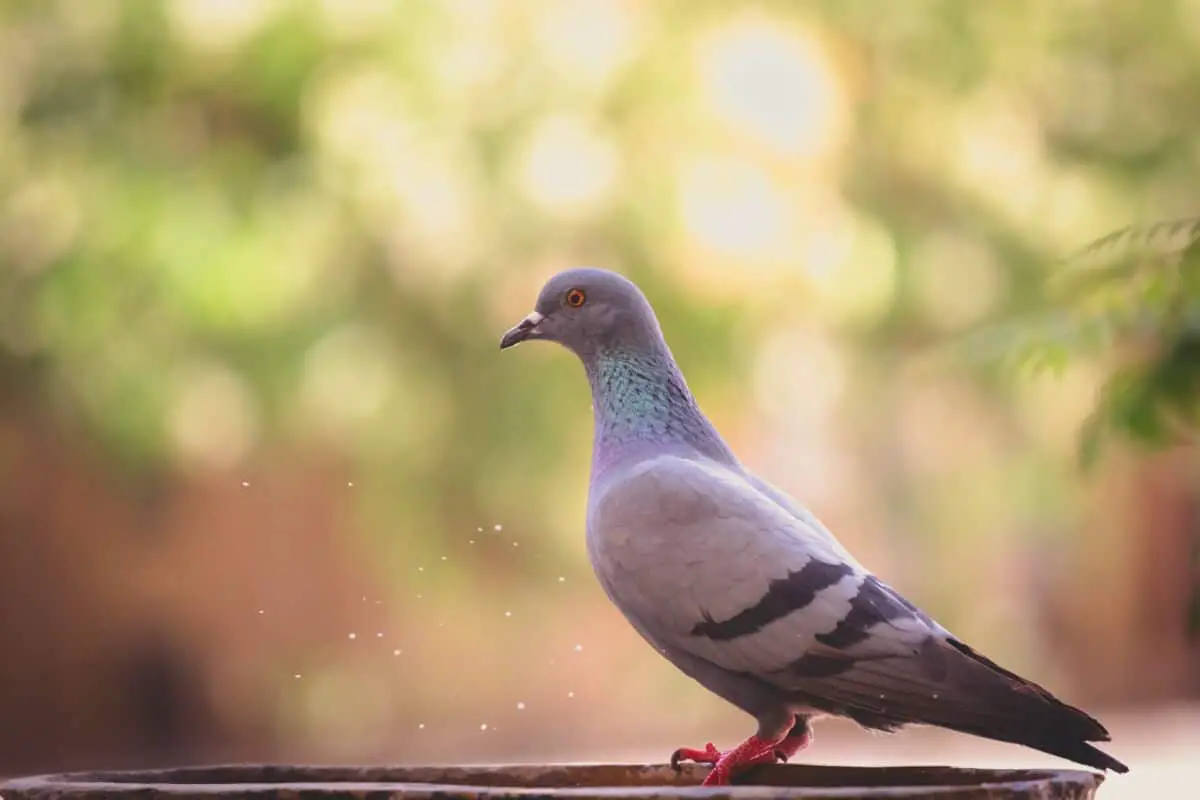Pigeons are one of those creatures people either love or hate. If you’re in the love camp but don’t have a garden, you can still appreciate these engaging birds close-up. All you need is a balcony, whether it’s at your home or place of work.
To attract pigeons to your balcony provide food, water, and a safe area for nesting. You can also create a welcoming environment with small trees and shrubs. Keeping potential predatory pets indoors will prevent them from scaring the pigeons away.
As you can see, it’s not hard to attract pigeons to your balcony. If you want more detail to increase your chances of success, you can find out more below.
1. Give a Pigeon-Friendly Food Like Grains and Seeds
Naturally, if you want to attract pigeons to your balcony, providing them with something to eat is the first thing to consider. Many people tend to feed birds leftovers, like bread. But this isn’t their natural diet and has little nutritional value. They’ll probably eat it because there’s no other option. But, if you want to feed them something nutritious, feed them the kind of foods they eat in the wild.
For pigeons, we’re talking about seeds and grains like cracked corn, barley, millet, wheat, sorghum, dried peas, and sunflower seeds. You can buy special mixes of pigeon seed, and if you’re starting out, it’s probably the best way to feed them. That way, you can ensure you give them the full range of nutrients.
This Vita Sunscript Dove & Pigeon Diet is an excellent choice. It contains a mixture of millet, oat groats, milo, and split green peas. So, it’ll give the pigeons a variety of grains and seeds from which to get nutrients.
Another mix with an even wider variety of ingredients is this Hagen Pigeon And Dove Staple Vme Seed. In addition to red and white millet, it contains red milo and whole wheat. There’s also canary grass seed, feed oats, cracked corn, oat groats, green split peas, and safflower seed. So it’ll give the pigeons an excellent varied diet.
You can also add to the diet some various types of greens and vegetables, like lettuce, kale, and chopped uncooked carrots.
2. Use a Feeder Suitable for Pigeons
As pigeons are larger birds, you’ll need to think about the type of feeder to use. If you watch pigeons feeding in the wild or cities, you’ll notice that they usually scavenge on the ground or other flat surfaces. So, think about scattering food on your balcony floor.
Or perhaps, invest in a feeding table if you have room to accommodate one. You can buy feeding tables on a stand, similar to this Dertyped Bird Stand. This type of feeder raises the feeding platform, making it easier to watch the pigeons as they feed.
Those types of stands take up a fair amount of floor space, which you may not have on your balcony. So, an alternative is a hanging feeding tray. An excellent example of what we mean is this WildBird Care Hanging Platform Bird Feeder. It has a screen-type tray that you can remove for cleaning.
Of course, if you don’t want to hang it up, you could always just put it on the ground at feeding time. That may be a tidier option than scattering seed on your balcony floor. If you have a balcony wall, a further option is putting the food on top of the wall itself.
3. Feed at Regular Times to Provide a Routine
It’s a good idea to feed pigeons around the same time each day. This may be either first thing in the morning or once in the morning and then again late afternoon.
Pigeons tend to return to feeding spots around the same time each day. So, sticking to a routine is good for keeping them coming back. Don’t overboard on the amount of food you put out, as you don’t want them to sit around all day or overnight.
Regulating the amounts you put out will also encourage the pigeons to eat the whole variety of seeds you provide. Otherwise, if food is plentiful, they may be prone to sifting through to find only their favorite seed or grain, leaving the rest to go to waste.
4. Provide a Source of Clean Water
Clean water is vital to good pigeon health. In addition to food, it’s another reason why pigeons are likely to stop by your balcony. As pigeons are mainly seed eaters, water is necessary because their dry diet doesn’t provide much natural moisture.
You can either provide a tray or dish of fresh water, provided that there’s a little depth to it. This is because pigeons immerse their beaks and suck water to swallow it. So, they’re not like other birds that dip their beaks and toss their heads back to drink.
So, avoid shallow containers and use something a bit deeper like the bowl in this video:
5. Watch From a Distance While Feeding Pigeons
It’s a good idea when you’re starting to feed pigeons to keep your distance from the feeder. Perhaps watch the birds from inside, to begin with. This will help them overcome any fear of a new feeding environment.
If your balcony is large enough, you could try sitting at one end, with the feeder at the other. But, you’ll need to remain as still as possible and avoid any sudden movements. It may take some time for the pigeons to become accustomed to you, so be patient.
6. Keep Pets Indoors During Pigeons’ Feeding Time
Cats, in particular, will likely take a keen interest in pigeons. This is especially the case if you plan to put the pigeon food on your balcony floor. But pigeons will find it equally disturbing to have a cat circling, even if your feeder is at a height.
So, it’s best to keep the cat and any other pet that might scare off the pigeons indoors when you put out your pigeon food.
7. Add Plants to Your Balcony to Make It Welcoming
Adding a bit of shrubbery to your balcony will give it a more naturalistic feel for the pigeons. It’ll also make them feel more secure in that they’ll have potential hiding places if needed.
Bare wood or concrete balconies probably won’t be too appealing. It’s still possible that you’ll attract pigeons eventually if you keep putting food out. But adding plants to soften the area should boost your chances of earlier success.
8. Provide Somewhere for Pigeons to Nest
Pigeons can be found nesting in all sorts of places. In built-up environments, they often nest under bridges and on ledges. In fact, they’re versatile when it comes to nesting.
If you want to attract them to your balcony during the nesting season, a high shelf on the house wall of your balcony may do the trick. It’ll need to be high enough to be out of the reach of predators. Also, think about providing shelter over it if there is none from the roof eaves.
You might also consider providing a source of nest-building material like straw or twigs in one corner of your balcony. They can use this to fill out the nesting shelf.
9. Remove Brightly-Colored Moving Objects
Any brightly colored or shiny moving objects like windmills or twirlers will put off most birds. So, if you want to attract pigeons to your balcony, you’ll need to remove such things. You can provide color by replacing these with plants, as suggested above. This will make your balcony a more welcoming feeding environment.
Conclusion
Attracting pigeons to your balcony isn’t hard to do if you take care of their basic needs in the form of food and water. Making the environment safe from predators will also help ensure success and keep them coming back time and again.

